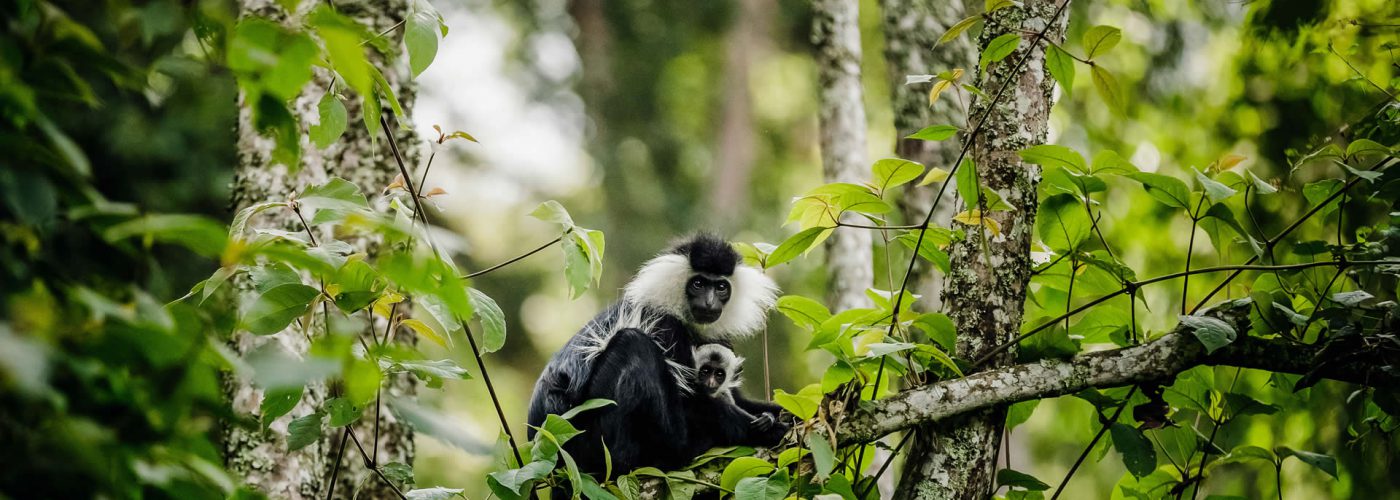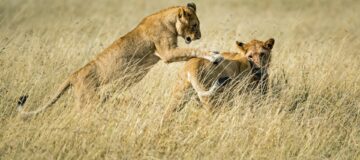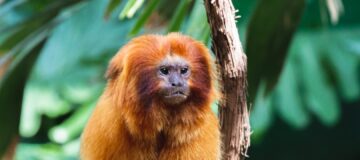Best Rwanda Safaris 2025 / 2026

Rwanda safaris are amazing. Booking Rwanda tours means lots of enjoyment and ecstasy. Rwanda is so easy to get to—roughly nine hours flight from London. If you fly overnight, you can be in its wilderness by midmorning. Even before you arrive in Kigali, you can see thousands of rolling hills under the flight path in the country. Kigali is where the whole Rwanda safari industry kicked off over two decades ago and today it’s still the springboard for Rwanda safaris.
Volcanoes National Park, Rwanda’s must-see wildlife destination is just a two hours’ drive away from Kigali International Airport, the gateway into the country. This montane rainforest is synonymous with Dianne Fossey following pioneering gorilla research here before her brutal murder in 1985. Today, this research carries on through the Karisoke Center, as established in her memory.
Each of the 10 habituated families that live in the park comprises of 6-32 members of different age brackets. Having been fully habituated, the gorilla groups aren’t bothered by the presence of visitors. The juveniles in the group that we shall book for you spend most of their time wrestling each other while their mothers sit back and live in the moment.
You can wrap up your stay in Volcanoes with a hiking Rwanda safari experience on Mountain Sabyinyo. It is an easy stroll as the gradient of the terrain is gently rising. The day-long adventure climaxes at a viewpoint from which you can behold Uganda, Rwanda, and Congo at the same time. Their borders intersect at its summit.
The sheer density of primates in Nyungwe National Park is probably no competition anywhere in the world. Here, chimpanzee tracking thrives and offers one excellent chance of encountering other 12 species including l’Hoest’s monkey, red-tailed monkey, and grey-cheeked mangabey.
Beyond that, Nyungwe National Park offers a remarkable canopy walk that is a must-do for people who are fond of heights and those who love awesome doses of adrenaline rush.
It will frighten and excite you in equal measure. You could easily spend your entire holiday here; but then you would miss out on Rwanda’s incredible diversity, which ranges from the historical genocide museums and cultural villages like Iby’iwacu.
We would always include the National Museum among our top Rwandan safari destinations. This historical treasure trove offers pretty fascinating traditional aspects of how Rwanda’s kings lived.
It further details the Rwandan monarchical system and circumstances that led to its abolition in the early 1960s. Here, you will find a royal court with a replica of the King’s traditional thatched huts.
And afterward, where better to wash off the dust of a perfect Rwanda safari than on the laid-back beachfront hotels of Lake Kivu. Kivu is a richly atmospheric and remarkably laidback freshwater lake that’s barely changed shape in centuries.
Mighty Akagera is probably Rwanda’s wildest Big 5 Park and offers the remotest Rwanda safari experience for most guests. You can spend several days exploring isolated parts of its open savannah and see almost nobody all the time you are there.
Akagera has so much to offer that the biggest difficulty facing prospective visitors is often where to start.
Volcanoes National Park
Also known as Parc National des Volcanoes is one of the best places in the continent to track mountain gorillas. First researched in the 1980s by Dianne Fossey, the primates are remarkably habituated. You are allowed to view them for an hour at a time.
This time is exclusive of the duration it will take you to access a random location where one of its 10 habituated families are grazing/foraging. Each is comprised of 6-35 members of different age brackets, all under the leadership of the most protective and fierce alpha male known as a silverback.
Set on the North-Western part of Rwanda, this 160Km2 montane rainforest covers a chain of five dormant volcanoes in the Virunga region, to be exact, Sabyinyo, Bisoke, Gahinga, Muhabura, and Karisimbi. In between, they are forested saddles where the gorillas spend much of the year due to the abundance of enormous groves of edible bamboo.
Volcanoes National Park is most famous for being only two hour’s drive from its country’s airport. This means that if one is short of time, they can fly in the early morning, track gorillas and depart for their next destination the same day.
Even if the celebrity gorillas featured in Dianne Fossey’s documentaries are now long dead, the tracking adventure here is an utterly rewarding experience. This explains why nature lovers still flock it even when its gorilla permits are now going for $1, 500 unlike four years ago when it was just $750.
In the interest of ensuring tourists have a qualitative experience, the maximum number of people allowed to see a gorilla family per day is 8.
In our experience, the only place that offers comparably good gorilla tracking is Uganda’s Bwindi Impenetrable National Park, and while the latter is preferable for its overall wilderness atmosphere and more varied wildlife, Volcanoes has the advantage of having golden monkeys and yes, it is possible to chance on them.
Although the forest elephants and buffaloes have been known to walk through the forest, it can be quite a hike to find them. Nonetheless, you are likely to come across their dung during your gorilla trek.
Despite Volcanoes being a high-end destination, it has an abundance of accommodations for both luxury and mid-range clients. While the average price for the former is $400 and above per person, the midrange is $100-300 per person full board.
Karisoke Research Center
A visit to Volcanoes National Park is incomplete without a three hours hike to a grave Dianne Fossey she was buried in 1985 after being killed by poachers.
This was in retaliation against her persistent fight to protect the gorillas from becoming critically endangered. Right next to Fossey’s grave in the forest is the grave of her dead gorilla friends, most of which had been killed by the very poachers that likely hunted her.
For a more in-depth experience, you can crown your day with a visit to Karisoke Research Center. It is an internationally renowned research station that Fossey started out in 1967 to study gorilla ecology, demography, and social organization. Looking at this grand headquarter, you will have a hard time believing that it started out so humbly.
A simple setup of two small tents in the wilderness of the Virungas. Today, it has become a center for the training of the next generation of conservationists and scientists in Rwanda.
Karisoke offers a very interactive and informative experience about mountain gorillas and their environment as well as on other gorillas subspecies. Most of all, it explains everything regarding Dian Fossey and the research she did on mountain gorillas in the Virunga region. A key highlight is a recreation of her office space featuring her desk and other personal items.
What to know
Wear gloves and a cover-up to protect yourself from the stinging flora during your visit to Volcanoes.
Nyungwe Forest National Park
This wild and pristine rainforest stretches over endless rolling hills towards Rwanda’s border with Burundi would be worth a visit without the obvious highlight of chimpanzee tracking. It is primarily comprised of wildlife that lives above 1,000m/3,281ft within the tropical belt. Except for Uganda’s Kibale National Park, no other park has as many primate species as Nyungwe, currently numbering 13. Apart from the chimps, the others include Rwenzori colobus monkeys, terrestrial l’Hoest monkeys, vervets, and a unique race of black-and-white colobus monkeys that is restricted to the Albertine Rift. The most common antelope species in the park are bushbucks and weyns’s duiker.
The chimpanzees are amazingly habituated and don’t seem to take any notice of tourists when they visit. This allows you to fully observe their behavior as you discover why they have been proven to have 98.7% common DNA with man. It doesn’t matter how many times you’ve heard it, staring a chimpanzee in the eye is undoubtedly a magical wildlife encounter. On average, the hike to see them takes two hours en-route a powerful forest waterfall or to the vast open swamp area that offers different sights into the stunning range of habitats.
The chimps spend much of their day feeding high up in the canopy, sitting on the forest floor grooming each other and matching through the underground. They detest noise and never hesitate to shy away from visitors wearing clothes with bright colors, especially red. It is a harsh reminder of bloodshed. You don’t need prior mountain climbing experience to be able to keep up with their pace as the terrain has a gentle gradient. One of the most exciting parts of viewing is when they (chimps) are hunting colobus monkeys, something they only do occasionally.
Canopy walk
Once you got yourself in this remote park, you might as well stay for some days. Luckily, there are lots of worthwhile activities to do. Top among them is the suspended canopy walk. It offers a spectacular bird’s view of the forest that makes one feel like it was transported to Earth from another planet. And perhaps nothing better conveys that sense of otherness than the fairytale look of the canopy.
Take your time strolling along its magical corridor and you will see lots of birds flying beside and below you. The descend down is a bit slower because you won’t be quite ready to leave this lovely place.
Bird watching
Thanks to its possession of more than 100 different varieties of trees that thrive at 1,000m/3,281ft within the tropical belt, Nyungwe attracts more than 300 bird species. That’s why it is recognized as an IBA (Important Bird Area) by Birdlife International. Here, you will find birds restricted to the Albertine Rift, and three species not found elsewhere on the eastern side of the Albertine Rift valley. These are the Albertine owlet, Rockefeller’s sunbird, and red-collared babbler all of which one could see as they hike to a forest waterfall or to the vast open swamp area in the park. Its trail is easier to navigate during the dry season from June to September.
Akagera National Park
Rwanda is known for its biodiversity, and Akagera National Park alone acts as proof. Elephants, lions, leopards, rhinos, and buffalos, plus a high diversity of migratory birds fill this nearly 1,122 km² found northeast of the capital of Kigali.
Named after a river that runs through it, Akagera features a string of forest-fringed lakes, papyrus swamps, and acacia woodland. Apart from having a healthy concentration of Burchell’s zebra and Masai giraffe, Akagera is also home to 11 antelope species. Common sightings include the gracious impala, topi, defassa waterbuck, bushbuck, and sitatunga.
Its lakes are beautifully laid out in spacious valleys that are surrounded by tall mountains. Their glassy, still surface and spectrum of colors, showcase some of the waters’ most fascinating qualities.
The spectacular beauty of these natural wonders might even make you forget about beaches altogether. If their wildly colored waters don’t do take your breath away, then the abundance of hippos and crocodiles will do the trick.
Aside from enjoying the lake’s Eden-like beauty, you will be spoiled for choice when it comes to activities in the area, whether it’s boat cruises or sport fishing.
If you are keen on bird watching, you can plan your visit for September, a time when its lakes are full of birds gathered for the breeding season.
Iby’iwacu Cultural Village
This cultural village was started out by a young man who is passionate about conservation. Afraid that wildlife in Volcanoes National Park was becoming critically endangered, he thought of creating an alternative source of livelihood for poachers and their families, and that’s how the idea of starting a cultural village came to mind.
Slowly, he started to persuade them that tourists would be interested in learning about their traditional culture and various interesting parts of Rwandan life. From blacksmithing to making banana beer to grinding flour, herbal medicine, and more. All of these can still be experienced during one’s visit to Iby’iwacu today and yes, you don’t just stop at watching. You are free to join at the moment.
Not only that, after being given historical lessons, you will be crowned a king/queen for a day. You will also get to witness a mock traditional wedding ceremony that is fired up by enthusiastic drumming and dancing.
By supporting this organization, one directly contributes to the vision of community involvement in conservation and sustaining the environment of the wildlife of Volcanoes, especially the precious mountain gorillas.
Kigali Genocide Memorial
In 1994, the skies came falling down on Rwanda. A genocide unfolded as the world watched on. In a space of fewer than four months, approximately one million Tutsis and moderate Hutus were systematically butchered by the Interahamwe army. Kigali Genocide Memorial is one of the memorials established in honor of the victims. Here, you will find mass graves of approximately 250,000 people.
The tour of the Kigali Genocide memorial starts with an informative audio tour (US$15) that offers an insight into the divisive colonialism that Rwanda underwent. As the guided tour progresses, the exhibits become steadily more powerful.
Watching testimonies from survivors of the crimes is a touching experience. One of the sections in the museum here remembers children who fell victim to the killers’ machetes. Their photos are captioned with intimate details about their favorite toys, their last words, and the way in which they were murdered for their race.
The upper floor of the museum is dedicated to informing visitors about other genocides that have unfolded in different parts of the world. This sets Rwanda’s nightmare in a historical context.
Once your tour is done, you can lay a rose or wreath on one of the mass graves.
Ethnographic Museum
Situated in the Huye district, en route to Nyungwe from Kigali, this museum showcases the way of life in Rwanda from the past up to today. It is in a very interesting building from an architectural perspective – all one floor.
This makes it so easy for most people to get around. It was constructed and gifted to Rwanda in the 1980s by the Belgium Government. This was in celebration of its 25 years of independence.
The museum is mostly devoted to pre-colonial history, mostly before the takeover of Rwanda by Germans in late 1800. Better still, there is a wall of post-colonial information. The museum contains several rooms beginning with the geological history of Rwanda.
Within rooms, there are sections devoted to different subjects’ and souvenirs: such as hunting, music, milk production, clothing, basketry, food, jewelry, and farming. Another room exhibits tools from the stone age to the 20th century.
Going by general consensus, the most interesting exhibit is a replica of a traditional royal home that you can walk into to see how the royals used to live and how their houses were constructed.
During your tour here, you will be accompanied by a Rwandan guide, a lovely woman wearing a traditional Rwandan formal dress. It sort of resembles a sari.
Outside the museum, you may get a chance to meet a lady who is making articrafts like a lovely basket known as Agaseke. After the tour, you may enjoy the beauty of the forest and garden around the museum.
Here, you will find a gift shop where you may buy handmade crafts that are designed with a Rwandese touch. Photography is not allowed.
Best time to visit Rwanda
The best time to visit Rwanda is the Dry season, from June to September.
























